
View of Jemez Mts. from the east. Thunderstorms often form over
the caldera in late summer.
Part 12. Valles Caldera
| Valles Caldera, also known as the Jemez Mountains,
is a giant (80 km/50 miles across) shield volcano in central New Mexico, at the
southern tip of the Rocky Mountains. |

Aerial view of the Caldera, photographed from
American Airlines flight Albuquerque-Chicago. |
Now only 1500 m/5,000' high, it had been much
higher until its cone collapsed about a million years ago, forming a crater 20
km/12 miles across and 300 m/1,000' deep. |
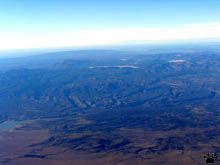
Aerial view of the Caldera. Grassy area of the crater
floor is visible just above the center of the photo. |

Satellite view of the caldera (courtesy USGS). Note San Diego
Canyon to the south, a number of inner peaks of various size. The
city of Los Alamos is just outside the right margin of the photo. |
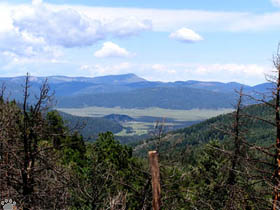
View of the Caldera from the crater rim, looking northwest. The
small cinder cone in the center of the picture is also visible
as a tiny dark dot at the center of the satellite photo to the left. |
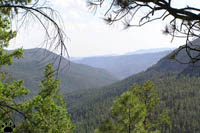
View down San Diego Canyon from the crater
rim of the Caldera. |
The crater was filled with a lake, which eventually
drained through San Diego Canyon to the south. Later, smaller eruptions created
numerous inner cones on the once-flat crater floor. |
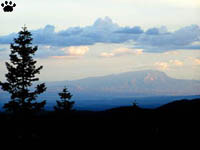
View of the Sandia Mountains from the
summit of Redondo Peak. |

View of the caldera floor. Redondo Peak is visible on the left. |

View of Redondo Peak from the north. At
3380 m/11,254', it is the tallest of inner cones,
and the highest point of the Jemez Mountains. |
The eruptions, which ended just 50,000 years ago,
had deposited layers of volcanic ash across large parts of North America. On the
outer slopes of the caldera, they get as thick as 300 m/1,000'.
|
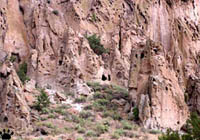
Caves in tufa layers, such as these at Bandelier
National Monument, have been inhabited by
people for thousands of years. |
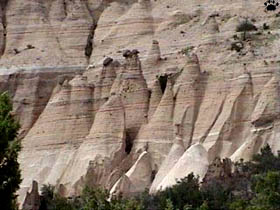 |
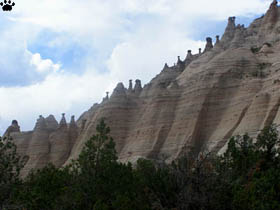 |
| Kasha-Katuwe, or Tent Rocks - one
of many interesting formations in eroding tufa deposits around the caldera. |
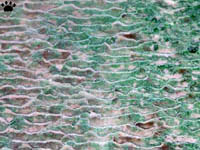
Travertine deposits with algae, Soda Dam.
Photographing inside the cave is very
difficult: camera lens instantly get fogged. |
Numerous hot springs are still scattered throughout
the Jemes Mountains. The most interesting is Soda Dam - a huge wall of travertine,
with a colorful cave containing a golden pool from which a hot stream is flowing
(below).
|
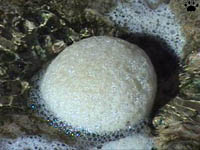
The stream flowing out of the cave at Soda Dam
contains weird balls of foam. They are the size
of an orange, and slowly rotate in one place. |
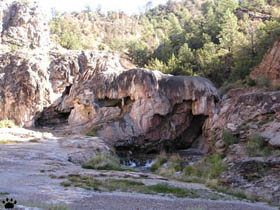 |
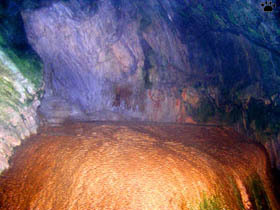 |
| View of Soda Dam (left) and the hot
spring inside the cave. |
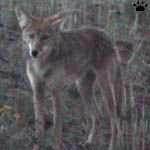
Coyote (Canis latrans). |
The caldera, now partly a National Forest, partly
a National Preserve, has been protected one way or another for decades. Alas,
forest fires spreading from nearby city of Los Alamos have destroyed much of the
forest, especially on the eastern side. There is still cattle grazing on the caldera
floor, the most unique part of the Jemez. Limited elk hunting is also allowed. |

Turkeys (Meleagris gallopavo). |
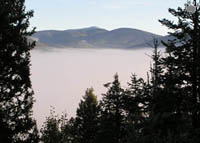
Morning fog in the caldera. |
Late September and early October, when the elk
rut, aspen leaves turn yellow, and morning fogs fill the crater, is the most beautiful
time of the year in the Caldera. |
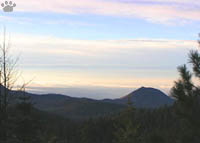
Morning fog around the Jemez Mountains. |
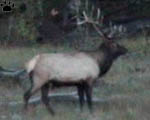 |
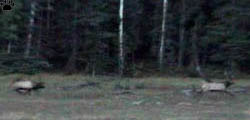 |
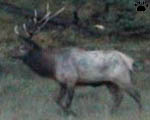 |
| Encounters between elk males seldom
result in fights: usually they instantly know who is stronger, and the winner
(left) chases away the weaker contestant (right). |

Long-tailed vole (Microtus longicaudus). |
Unless you are an elk hunter lucky enough to win
the lottery, your access to the caldera is limited to National Forest lands and
one short trail into the Preserve. Still, there's a lot to see there. |
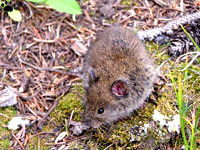
Long-tailed vole. |

Montane vole (M. montanus). |

Baby montane vole. |
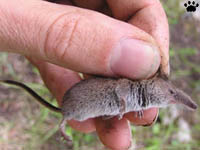
Dwarf shrew (Sorex nanus). |
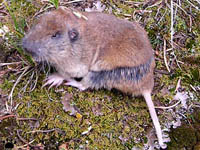
Western pocket gopher (Thomomys bottae) is
more commom at lower elevations. |
Pocket gophers (Thomomys) are very common
in the caldera. Meadows and forests are dotted with their burrows; their digging
activity improves the soils. They are brave and smart animals. |

If caught in the open, Western pocket gopher
doesn't hesitate to defend itself. |
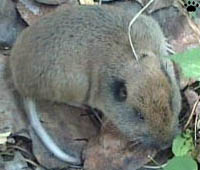 |
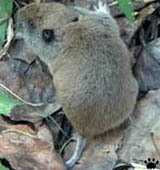 |
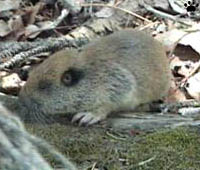 |
| Baby Northern pocket gopher (Thomomys
talpoides). This species is more common at higher elevations; it can usually
be identified by large dark spots behind the ears. It is less aggressive than
Western pocket gopher. |
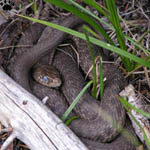
Western terrestrial garter snake
(Thamnophis elegans). |
The most interesting inhabitant of the caldera
is Jemes Mountains salamander. It is an Ice Age relict, separated from its closest
relatives on the Pacific Coast by almost a thousand miles of dry mountains and
deserts. It has suffered a lot of habitat loss from forest fires, but is still
common in some parts of the area. |
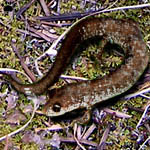
Jemez Mountains salamander
(Plethodon neomexicanus). |
 |
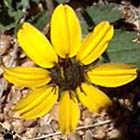 |
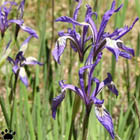 |
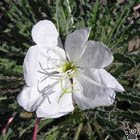 |
| Common flowers of the caldera, left
to right: false tahoka daisy (Machaeranthera tanacetifolia), chocolate
flower (Berlandiera lyrata), Rocky Mountains iris (Iris missouriensis),
birdcage evening-primrose (Oenothera deltoides). |
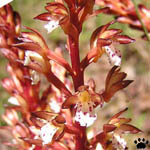
Spotted coral root
(Corallorhiza maculata). |
The salamander's ability to survive here is probably
due to relatively vet local climate. During the monsoon season (typically late
July to early September), thunderstorms can be seen forming over the Jemez Mountains
almost daily. Wet climate is also good for wildflowers - there's a lot of them
here, including some rare species and many common, but beautiful ones. |
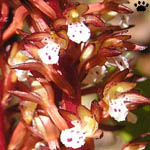
Spotted coral root
(Corallorhiza maculata). |
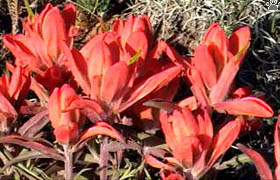
Indian paintbrush (Castilleja linariifolia). |
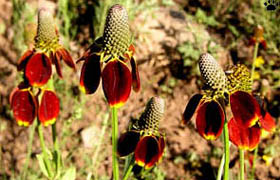
Mexican hat (Ratibida columnaris). |
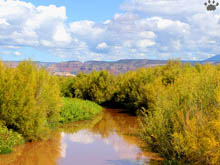
Jemez River flows out of the Jemez Mountains. |
In winter, the Caldera gets more snow than most
other parts of the state. Traveling off the main road gets difficult, but it's
still a wonderful place to visit. |
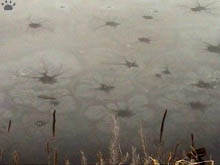
Patterns of ice on freezing Jemez River. |
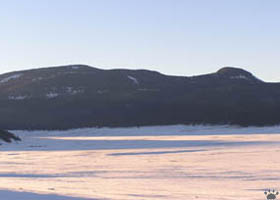 |
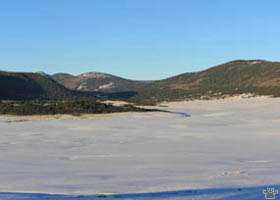 |
| Winter in Valle Grande, the largest
flat area inside the crater. |
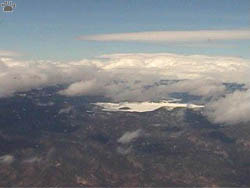
Aerial view of the Caldera in March, photographed from
Delta Airlines flight Cincinnatti-Albuquerque. |
In spring, snow remains inside the crater longer
than elsewhere, often until April. |
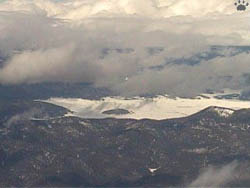
Aerial view of the Caldera in March. The crater floor has more
snow than the surrounding hills. |

Elk in the Caldera are among the largest in North America. |
Part 13. Spanish Peaks
Back to Part 11
Home
|
|